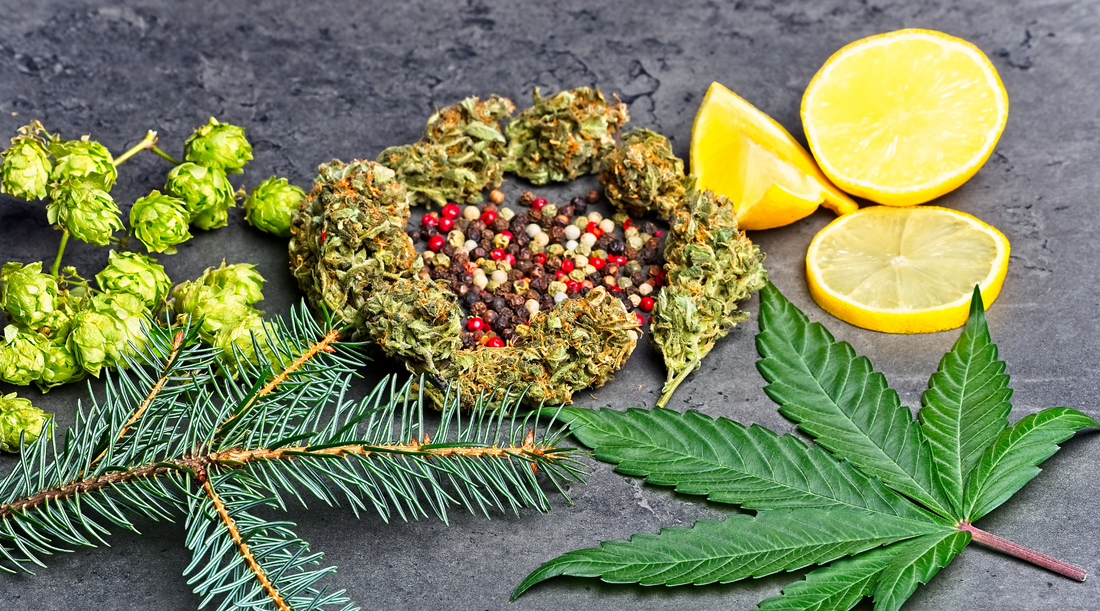The Cannabis plant contains a wide variety of phytochemical (or plant compounds). The most well known of these by far are the cannabinoids as they are largely exclusively found in cannabis and hemp but there is another special group of chemicals found in cannabis, these are called terpenes.
What are Terpenes?
Terpenes are fragrant oils that give all plants, including cannabis and hemp, their particular aromas. Terpenes are what make blueberries smell like blueberries, lavender like lavender, and cannabis… well, like cannabis.
But terpenes are so much more than just their aromatic nature. They play an even more important role in providing plants with many of their therapeutic and medicinal properties. This is because of the way they interact with our olfactory system (more on that later). Similarly, cannabis terpenes are also what create the subtle differences in effects across the various cultivars.
Some common cannabis terpenes are:
- Myrcene with powerful sedative effects
- Beta-Caryophyllene produce calming sedative effects and has anti-depressant, anti-inflammatory, anti-microbial, and gastrointestinal protection properties
- Humulene’s chemical structure is almost identical to beta-caryophyllene and has similar properties
- Eucalyptol produces energising, uplifting effects
- Nerolidol has calming, relaxing effects
- Ocimene is an uplifting, energising terpene
- Pinene is responsible for the refreshing, earthy, and woodsy aroma of pine Forrests and produces an energising effect
- Linalool is responsible for the smell of lavender and has powerful relaxing and calming properties
- Limonene has a citrusy, sweet-tart, and fresh smell and is known for producing mood-elevating effects
- Terpinolene has a sedative and relaxing effect, and relieves insomnia
How are Terpenes different from Cannabinoids
Interestingly, phytocannabinoids and terpenes are actually quite similar. In fact, because phytocannabinoids are terpenophenolics - compounds that are part terpenes, part natural phenols - their molecular structures are considered so similar that some experts think that cannabinoids are mutated forms of terpenes that developed exclusively in Cannabis sativa.
This is also the reason both terpenes and cannabinoids have the ability to interact with our bodies and have direct physiological interactions, effects and benefits. So much so that the terpene beta-caryophyllene interacts with the endocannabinoid system in a very similar way as phytocannabinoids do.
But, despite this, there is one very important difference.
Terpenes have a repetitive aromatic 5-carbon ring called isoprene (instead of the phenol component of cannabinoids) and that makes it an aromatic molecule and much more volatile than cannabinoids. It also means terpenes enter the body via a different pathway, so the way they interact with our bodies will also differ.
How do Terpenes work?
Have you ever walked through a herb garden and felt better? Or smelled cinnamon and immediately thought of Christmas? You can thank terpenes for this.
Terpenes first evolved to protect plants against microbes and predators, while also attracting pollinators like butterflies and bees. Because of this, terpenes target the sense of smell in insects and animals, and therefore also humans and its through this that they interact with our minds and bodies.
Scientists have shown that terpenes work by activating the olfactory system, triggering communications with the receptors in the limbic system of our brains. The limbic system controls “high-level” brain functions such as emotions, stress response regulation and memory. Thus, when you inhale (or smell) terpenes, they activate these higher order brain functions, opening the door to a wide variety of mental health benefits.
But, terpenes do more than just make us feel emotionally better. They also have very definite physical effects, including having antioxidant, anti-bacterial, anti-fungal, anti-microbial and even anti-cancer properties.
Cannabinoids and terpenes are better together
Herbalists have known for millennia that whole plant extracts work better than single compounds. This effect now has a name and is called the “entourage effect”.
Since 1998, cannabis researchers noted that there is a botanical synergy between CBD and THC, most notably in how the former reduces many of the unwanted side effects of the latter. But there is also a marked beneficial interaction between these major cannabinoids and other “minor” cannabinoids, terpenoids and flavonoids.
For instance, we now know that both cannabinoids and terpenes increase blood flow, enhance cortical activity and kill respiratory pathogens. Similarly, data strongly suggests that cannabinoid-terpene interactions also produce synergistic effects when it comes to treating conditions such as pain, inflammation, anxiety, depression, epilepsy, cancer, infections and even addiction.
Where do I find Terpenes?
Terpenes are literally all around us, in all types of aromatic herbs, fruits, vegetables and flowers, and as such, also in the essential oils derived from these plants. Similarly, because hemp terpenes are formed in the same resinous trichomes as cannabinoids, we can find an abundance of terpenes in hemp extracts. Knowing what we know about the profound effects of terpenes, we decided to include real cannabis terpenes in both our Otherside CBD Oils and our CBD vape cartridges.

